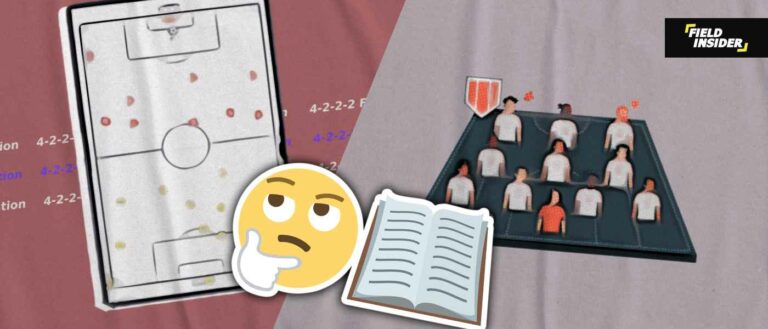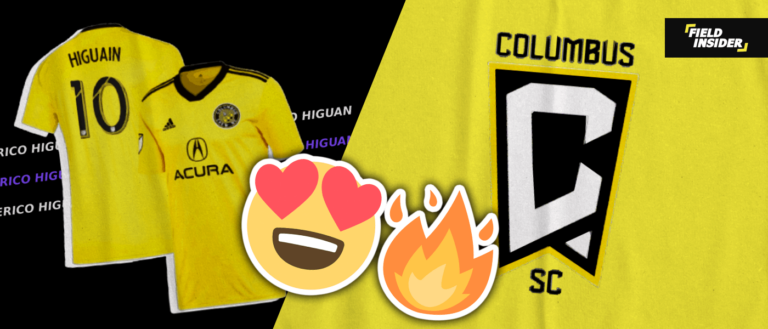Best Attacking Formation In Football (Soccer): Top 10
In the high-stakes world of football, an attacking formation is the cornerstone of a team’s offensive strategy. The attacking strategy emphasizes advancing into the opponent’s penalty area to generate goal-scoring opportunities.
This approach provides an enjoyable spectacle for fans and is a tactic embraced by certain coaches. Conversely, those with a more idealistic viewpoint regard it as the proper approach to play this sport.
This article delves into the top 10 attacking formations, offering insights into their unique aspects, historical contexts, and tactical strengths and weaknesses.
Whether you’re a seasoned coach (on EAFC or Football Manager too 🤭), a budding player, or a fervent fan, understanding these formations is crucial in appreciating the beautiful game’s intricacies.
Key Takeaways
| Topic | Key Takeaway |
|---|---|
| The Attacking Formation | What makes an attacking formation. |
| 4-3-3 Formation | Balanced approach with emphasis on wide play and versatility, ideal for possession-based football. |
| 3-4-3 Formation | Aggressive attacking setup, blending solid midfield presence with a three-player backline, suitable for high-pressing tactics. |
| 4-2-3-1 Formation | Offers tactical flexibility with a strong midfield foundation, balancing defensive solidity and attacking prowess. |
| 3-5-2 Formation | Combines defensive robustness with offensive flexibility, effective in controlling the midfield and providing width through wing-backs. |
| 4-4-2 Formation | A classic formation known for its straightforward approach and balance, suitable for direct play and exploiting the flanks. |
| 5-3-2 Formation | Focuses on defensive resilience, effective for counter-attacking strategies and quick transitions. |
| 4-1-4-1 Formation | Emphasizes midfield control, ideal for possession-based play and teams aiming to dominate the game’s tempo. |
| 3-3-4 Formation | Ultra-offensive formation used for goal-heavy strategies, effective in overwhelming defenses with attacking numbers. |
| 4-3-1-2 Formation | Centers around a diamond-shaped midfield, offering a balanced mix of defense and attack, with a focus on creative playmaking. |
| 2-3-5 Formation | An archaic but historically significant formation emphasizing attacking play with five forwards, influencing modern attacking tactics. |
| 3-5-2 Vs. 4-2-3-1 | A theory-oriented, experimental approach based on positional data. |
What is An Attacking Formation In Football?
In football, an attacking formation typically refers to a tactical setup that prioritizes offensive play, often involving more players in forward positions and strategies focused on scoring goals.
These formations usually feature fewer defenders and more midfielders or forwards, with common examples being the 4-3-3, 3-4-3, or 4-2-3-1.

These setups encourage wide play, creative midfield roles, and multiple attacking options, aiming to dominate possession, create numerous scoring opportunities, and finally, exert sustained pressure on the opposition’s defense.
The choice of an attacking formation reflects a team’s intent to take the initiative in the game, prioritizing goal-scoring over a more balanced or defensive approach.
I. 4-3-3 Formation
The 4-3-3 formation, central to the philosophy of total football, suits teams that focus on maintaining possession and exploiting the pitch’s width.
The 4-3-3 SetUp
This tactical setup includes three forwards – typically two wingers and a central striker, whose roles involve both scoring and creating opportunities. Additionally, the midfield trio, often a blend of defensive and creative players, plays a pivotal role in controlling the tempo of the game and linking defense with attack.
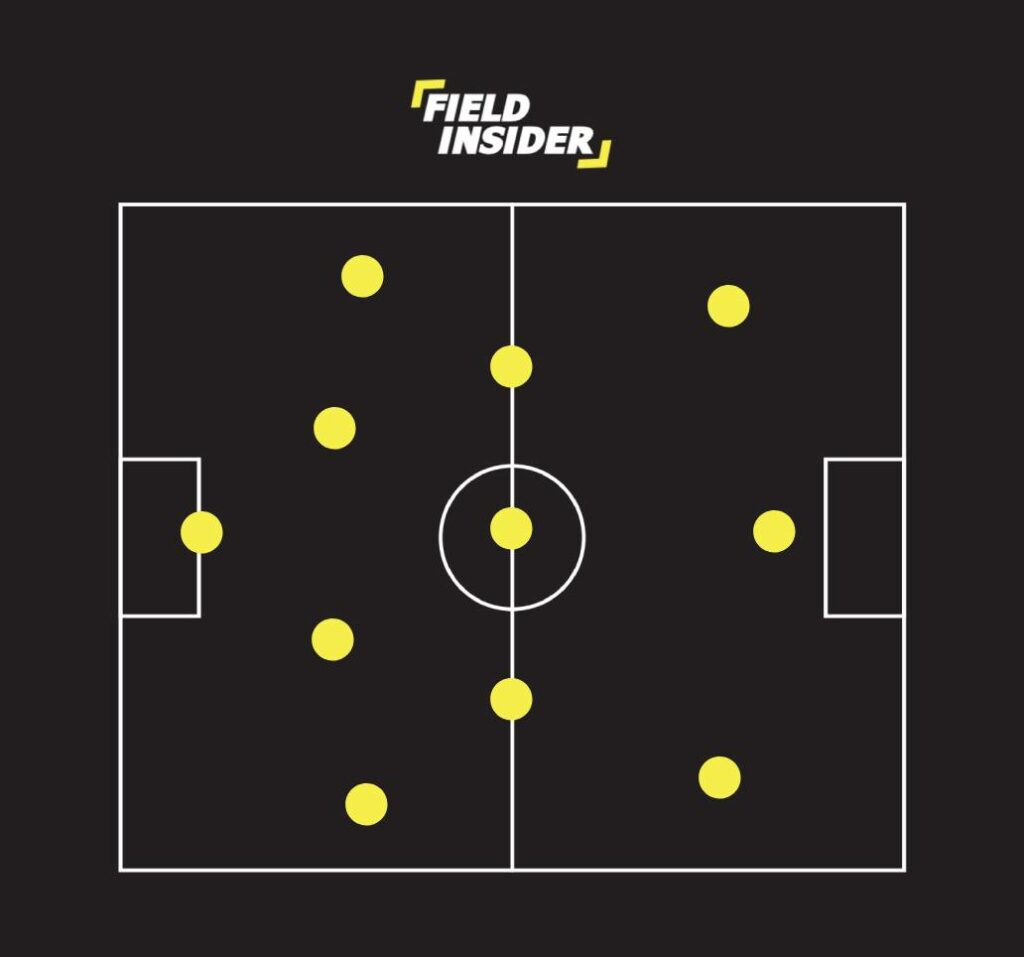
Defensively, the formation is structured with four players, balancing the team’s offensive ambitions with a sturdy defensive line.
The Birth Of Total Football
This formation first rose to prominence under the legendary Rinus Michels at Ajax, where it was integral to their European success in the early 1970s. Moreso, its effectiveness was further highlighted by Pep Guardiola’s tenure at FC Barcelona.
Barcelona’s Tiki-Taka Era
Under Guardiola, Barcelona refined this formation, emphasizing a possession-heavy, attacking style of play that led to an era of dominance, both domestically and in Europe, marked by numerous La Liga victories and Champions League triumphs.
The team’s success during this period wasn’t just about winning titles; additionally, it was a demonstration of how the 4-3-3 formation, when executed with precision and skill, could dominate football at the highest levels.
Why is The 4-3-3 A Good Attacking Formation?
In the 4-3-3 formation, wingers are key to the attack, either cutting inside to add a goal threat or staying wide to deliver crosses, effectively stretching the defense.
Central midfielders complement this by advancing into the attack, often creating a numerical advantage in the final third. This synergy between the wingers and midfielders makes the attack varied and dynamic, posing multiple challenges for opposing defenses.
Pros & Cons Of The 4-3-3
| Pros | Cons |
|---|---|
| Balanced attack and defense | Requires versatile wingers |
| Great for possession play | Can be vulnerable on the flanks |
| Allows for quick transitions | Demands high stamina from players |
II. 3-4-3 Formation
The 3-4-3 formation represents a bold, attack-oriented approach that balances offensive thrust with midfield solidity, underpinned by a trio of defenders. This formation is particularly effective for teams that employ high-pressing tactics, aiming to regain possession quickly and launch rapid attacks.
The 3-4-3 Setup
With three players at the back, the formation provides a solid defensive core while the four midfielders, often including two wing-backs, offer both width and support in midfield.
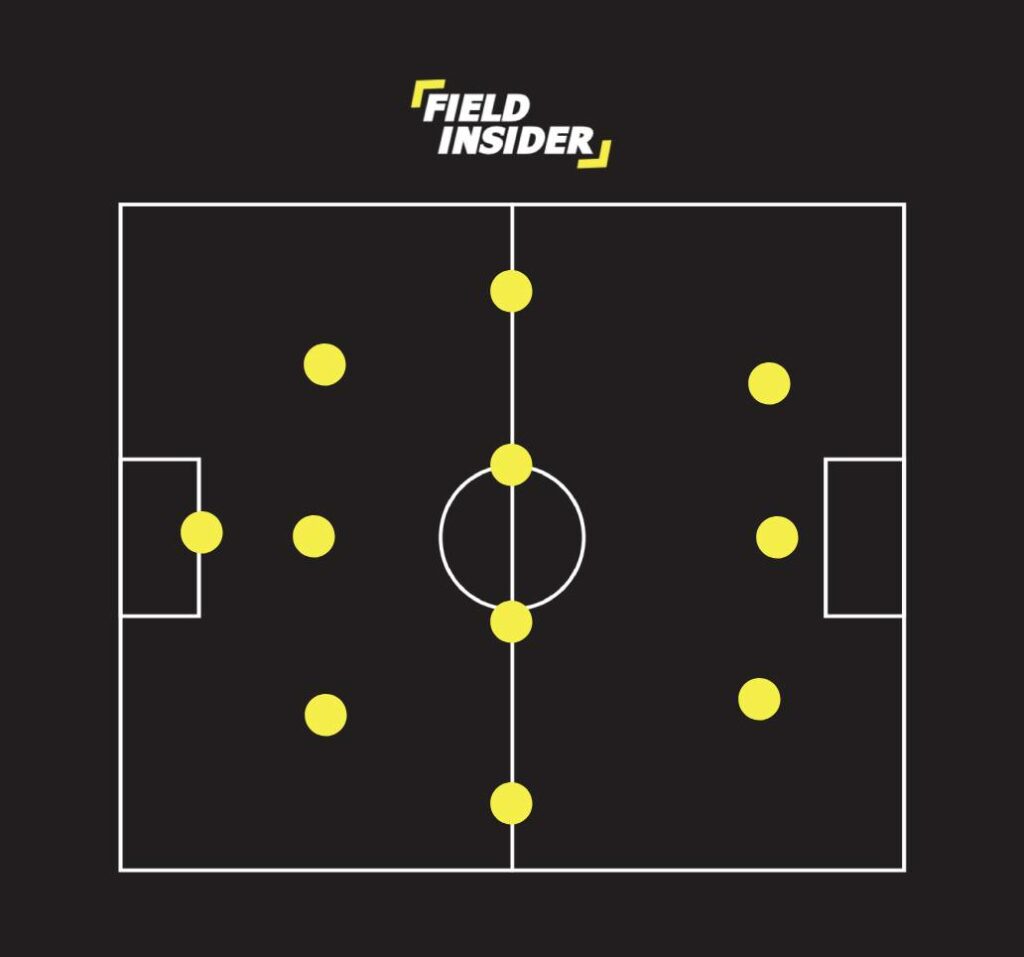
The forwards in this setup are required to be capable of interchanging positions, and adept at exploiting the spaces created by the movement of their teammates.
As a result, this setup allows for a fluid transition from defense to attack, making it ideal for teams with versatile players who can adapt to quick changes in the game’s dynamics.
Conte’s Record Breaking Season
Antonio Conte’s Chelsea in the 2016-17 Premier League season is a prime example of the formation’s effectiveness. Conte’s strategic implementation of the 3-4-3 enabled Chelsea to dominate the league, achieving a record 30 league wins and securing the title.
The formation not only brought defensive stability to the team but also unleashed their attacking potential, making them a formidable side that combined tactical discipline with offensive flair.
Why is The 3-4-3 A Good Attacking Formation?
In the 3-4-3 formation, the role of wing-backs is vital as they are key to providing width, stretching the opposition’s defense, and therefore creating space in wide areas.
This width allows midfielders and forwards more room to maneuver, facilitating the creation of overloads in strategic areas of the pitch, which can be critical in breaking down organized defenses.
The formation is particularly effective during quick transitional phases of play, where rapid switches from defense to attack can catch opponents off guard.
This multi-dimensional approach in attack, combined with the stability offered by the midfield and defense, makes the 3-4-3 a formation that can adapt to various in-game scenarios, making it both unpredictable and effective.
Pros & Cons Of The 3-4-3
| Pros | Cons |
|---|---|
| Strong midfield presence | Less defensive cover at the back |
| Good for high-pressing tactics | Can be overrun by teams with extra midfielders |
| Flexible for attacking plays | Requires highly disciplined wing-backs |
III. 4-2-3-1 Formation
The 4-2-3-1 formation is highly valued for its tactical versatility and strong midfield structure, making it adaptable to a variety of attacking plays.
The 4-2-3-1 Setup
This formation is anchored by two defensive midfielders who provide a stable base, hence allowing the three attacking midfielders and the lone striker to aggressively pursue offensive opportunities.
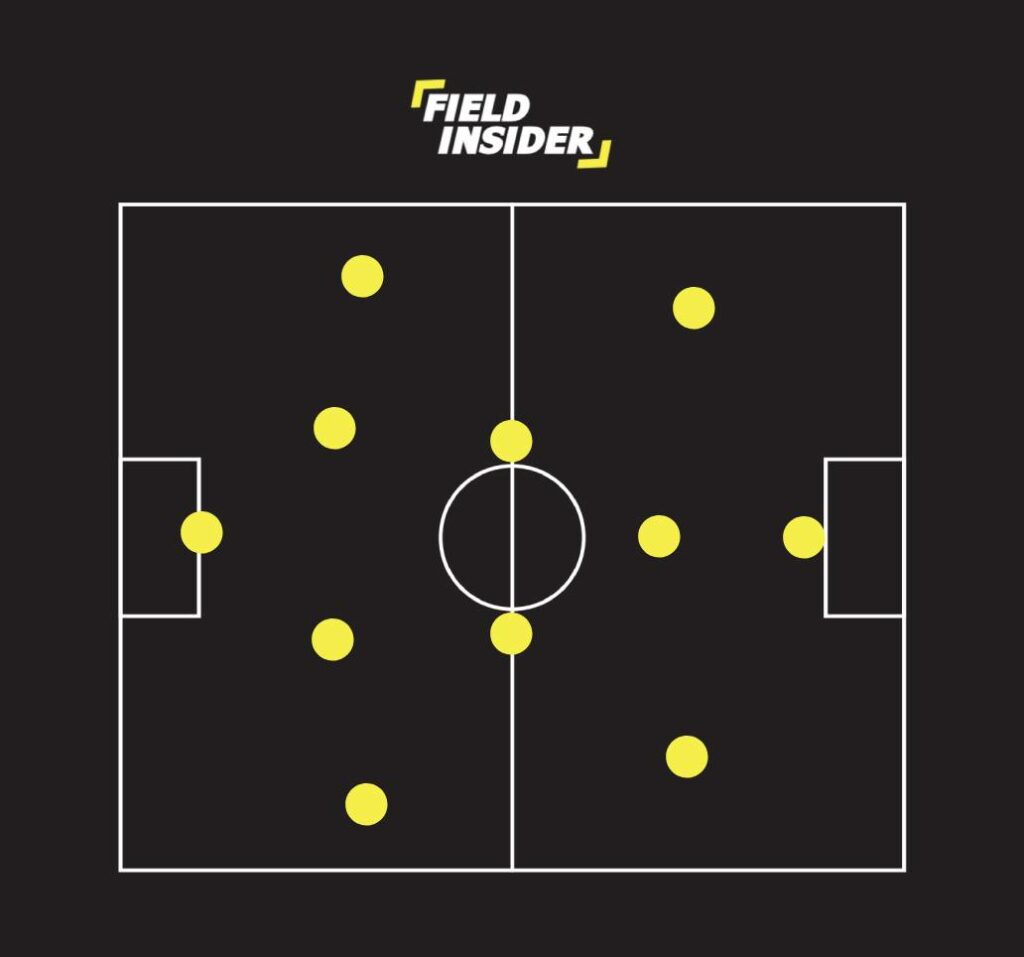
The wide players in the attacking trio can either cut inside to support the striker or stay wide to stretch the defense, thereby creating space for overlapping full-backs or penetrating runs from midfield.
Goals Under Mourinho?
This formation gained significant acclaim under Jose Mourinho’s management at Real Madrid during their triumphant 2011-12 La Liga season, where it was instrumental in breaking records for the most goals scored and the highest points tally in a single season.
The 4-2-3-1’s blend of defensive solidity and attacking versatility was key in Real Madrid’s ability to dominate the league, showcasing the formation’s effectiveness at the highest level of football.
Why is The 4-2-3-1 A Good Attacking Formation?
In the 4-2-3-1 formation, the central attacking midfielder (CAM) is the linchpin of the attack, skillfully orchestrating plays and linking midfield to the forward line. This role involves dropping into open spaces to collect the ball, either to push forward or to distribute it effectively to the attacking trio.
The wide players in this trio have the versatility to either maintain width, providing crosses from the flanks, or to cut inside, creating direct goal-scoring threats or aiding the central striker.
The lone striker plays a vital role, often coordinating with the CAM and wide players, using intelligent movement to exploit defensive gaps. This player’s ability to hold up the ball is crucial, drawing defenders and creating opportunities for the attacking midfielders to converge in the offensive play.
Thus the synergistic interaction between these attacking roles renders the 4-2-3-1 formation highly effective, offering multiple strategies to dismantle the opposition’s defense.
Pros & Cons Of The 4-2-3-1
| Pros | Cons |
|---|---|
| Flexible and adaptable | Can isolate the striker if not supported |
| Solid defensive foundation | Requires creative attacking midfielders |
| Balances midfield and attacking roles | Demands high coordination among players |
IV. 3-5-2 Formation
The 3-5-2 formation, with its blend of defensive robustness and offensive dynamism, has proven to be a formula for success, particularly evident in the achievements of Juventus between 2011/12 and 2019/20 seasons.
The 3-5-2 Setup
This formation employs three central defenders to provide a secure defensive line, supported by two wing-backs who play a vital role in adding width and depth to the team’s attacking play.
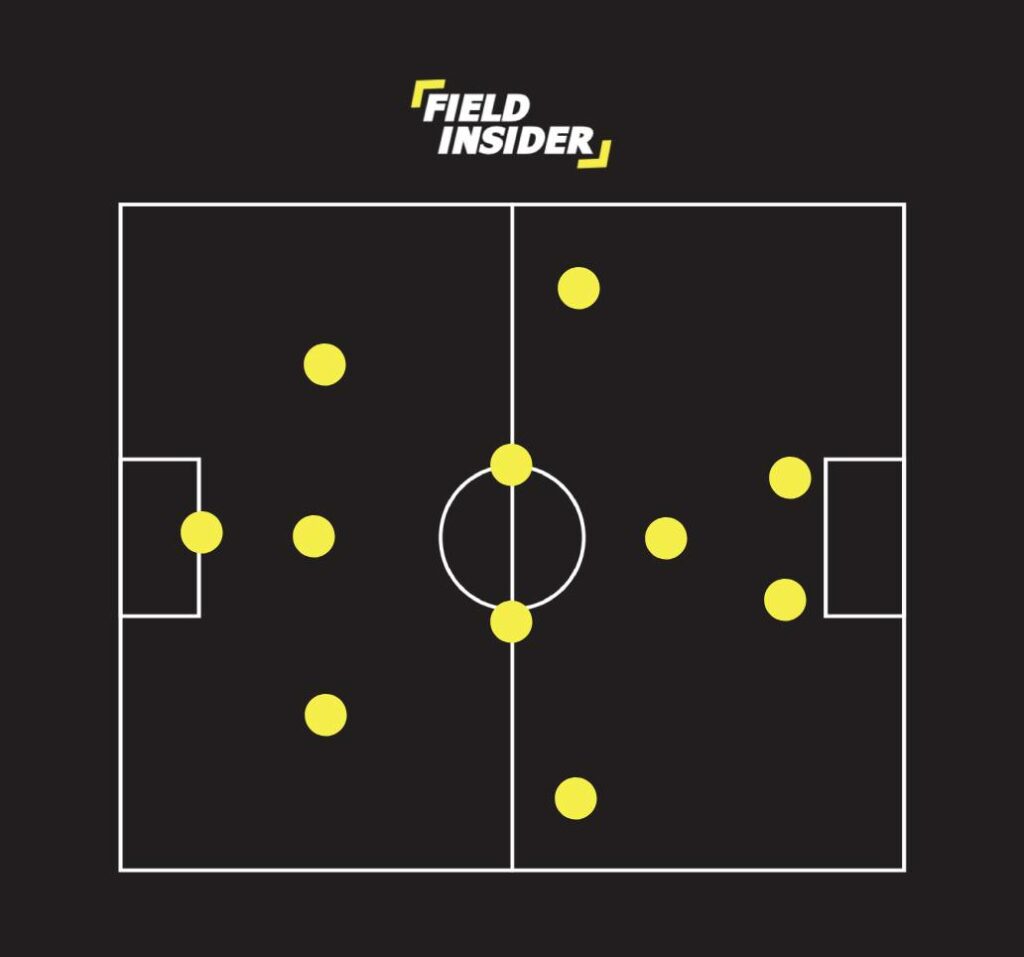
The midfield, consisting of three players, is pivotal in controlling the game’s tempo, enabling the team to switch seamlessly between defense and attack.
These midfielders balance their duties between shielding the backline and supporting the forwards, often joining the attack to create numerical superiority in the final third.
The two strikers at the front provide different attacking dimensions, capable of working in tandem to exploit spaces in the opposition’s defense.
Juventus’ Serie A Dominance
Juventus’ mastery of the 3-5-2 formation under managers Antonio Conte and Massimiliano Allegri illustrates the profound impact of this tactical system on their domestic dominance.
In fact, this formation was central to their 9 consecutive Serie A titles, showcasing how effectively it can be implemented at the highest level of football. In this setup, Juventus combined a rock-solid defensive structure with a midfield capable of both controlling the game and launching swift attacks.
The three central defenders, Bonucci, Chiellini and Barzagli, provided a nearly impenetrable backline, crucial in a league known for its defensive rigor.
Why is The 3-5-2 A Good Attacking Formation?
In the 3-5-2 formation, wing-backs are essential for providing attacking width, dynamically joining the forward line to create overloads and stretch the opposition’s defense. Additionally, the midfield orchestrates the game’s tempo, feeding the ball to the strikers and supporting the attack.
The two strikers up front offer diverse attacking options, either combining to create scoring opportunities or exploiting spaces individually, thereby adding a multi-dimensional threat to the team’s offensive arsenal.
Pros & Cons Of The 3-5-2
| Pros | Cons |
|---|---|
| Strong central midfield | Can struggle against wide formations |
| Good defensive solidity | Wing-backs must be highly energetic |
| Versatile in attack and defense | Requires well-coordinated center-backs |
V. 4-4-2 Formation
The 4-4-2 formation is a classic and enduring tactical setup in football, known for its simplicity and effectiveness.
The 4-4-2 Setup
Characterized by its balanced structure, the formation features two central defenders and midfielders, two wide defenders and midfielders, and two strikers, providing a clear and straightforward approach to both attacking and defending.
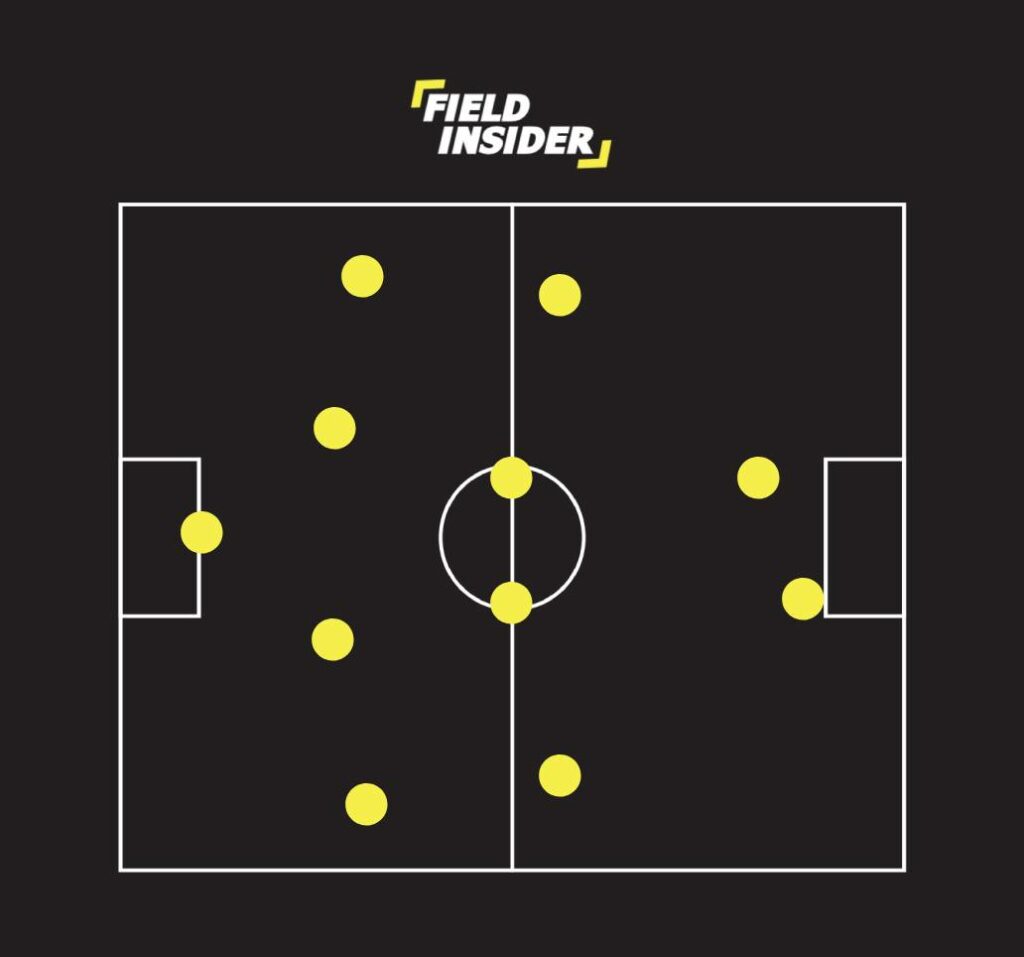
The 4-4-2’s blend of tactical clarity and versatility make it a formidable and reliable strategy on the biggest stages of club football.
Sir Alex Ferguson’s OlD Reliable
The 4-4-2 formation, played a pivotal role in the remarkable success of Sir Alex Ferguson’s Manchester United. Under Ferguson’s masterful guidance, this traditional setup was transformed into a dynamic and powerful tool, propelling United to an array of triumphs.
Including numerous Premier League titles and a notable UEFA Champions League victory in 1999. The formation’s two banks of four provided a robust defensive structure, while the pairing of strikers upfront offered a potent attacking threat.
Consequently, this was exemplified by the legendary striking duos like Dwight Yorke and Andy Cole, whose partnership was instrumental in United’s treble-winning season.
Ferguson’s ability to adapt the 4-4-2 to the strengths of his evolving squad over the years was key to maintaining Manchester United’s competitiveness and dominance in both domestic and European football.
Why is The 4-4-2 A Good Attacking Formation?
In the 4-4-2 formation, wide midfielders are crucial for their ability to deliver crosses from the flanks, creating scoring chances for the strikers.
The two strikers play complementary roles; one often focuses on hold-up play, retaining possession and laying off the ball, while the other exploits spaces, using quick movements to threaten the opposition’s goal.
This combination of wide play and diverse striker capabilities provides a dynamic and multi-faceted attacking approach, hence making the 4-4-2 effective in breaking down defenses through both aerial and ground routes.
Pros & Cons Of The 4-4-2
| Pros | Cons |
|---|---|
| Simple and easy to implement | Can lack creativity in midfield |
| Good width for crossing | Vulnerable to teams with extra midfielder |
| Solid defensive structure | Requires hardworking midfielders |
VI. 5-3-2 Formation
The 5-3-2 formation, renowned for its defensive solidity, is particularly effective for teams that prioritize counter-attacking strategies.
The 5-3-2 Setup
This formation employs five defenders, including three central defenders and two wing-backs, hence creating a robust defensive line capable of absorbing pressure.
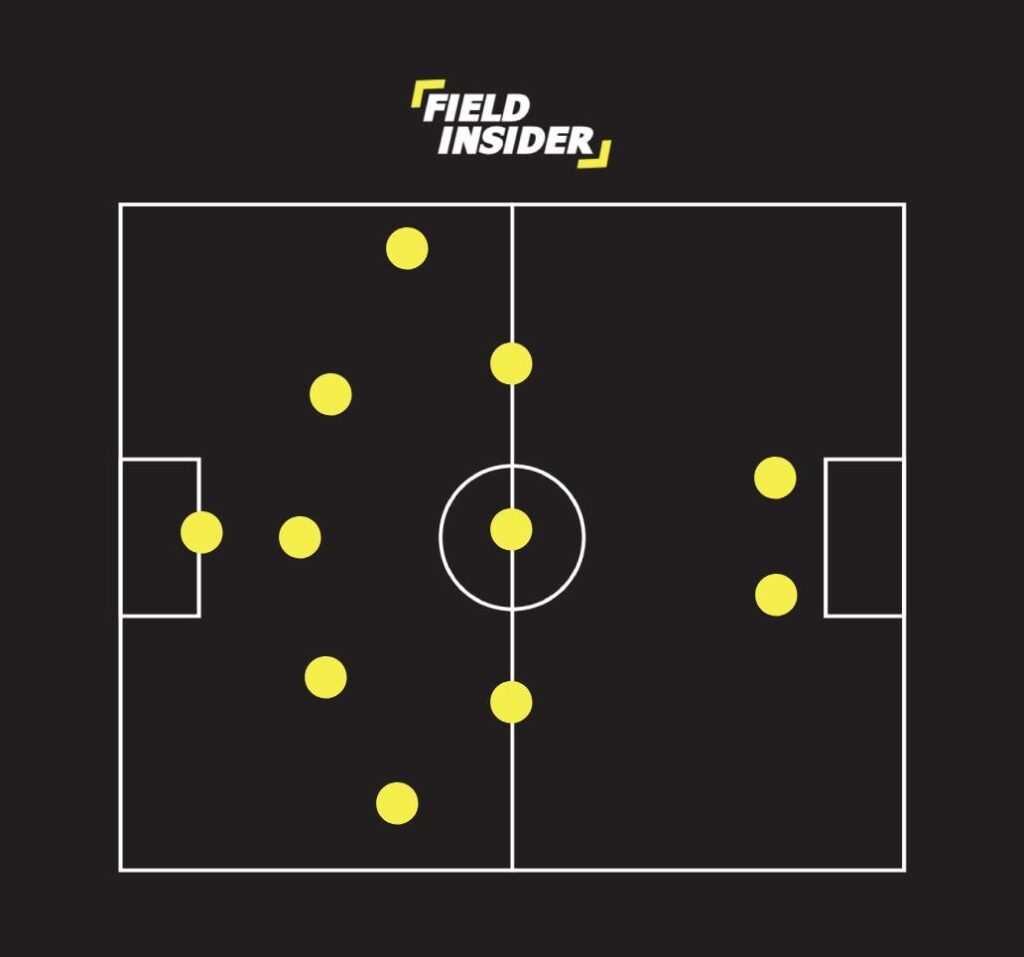
The midfield trio, often a blend of defensive and box-to-box midfielders, plays a key role in transitioning from defense to attack, swiftly turning defensive plays into offensive opportunities.
van Gaal’s 2014 World Cup Masterclass
Louis van Gaal’s Netherlands team in the 2014 World Cup is a prime example of the 5-3-2’s effectiveness. Under his guidance, the Dutch team utilized this formation to create a compact and impenetrable defensive unit while exploiting the pace and skill of their forwards in rapid counter-attacks.
This approach propelled the Netherlands to a third-place finish in the tournament, therefore showcasing the 5-3-2 as a tactically astute choice for teams looking to strike a balance between a secure defense and a threatening attack.
Why is The 5-3-2 A Good Attacking Formation?
In the 5-3-2 formation, the emphasis on quick transitions is a key aspect of its attacking strategy. Consequently, the wing-backs play a pivotal role in this regard, swiftly advancing up the pitch during counter-attacks, providing both width and additional options in the forward thrust.
Furthermore, they are essential in turning defense into attack, offering crosses from the flanks or directly joining the offensive play. The midfielders, often positioned to cover ground efficiently, are crucial in quickly distributing the ball to the strikers or advancing with it themselves.
The strikers, usually fast and agile, are tasked with exploiting the spaces created by these transitions. Their ability to move rapidly and their positional awareness enable them to latch onto through balls or capitalize on defensive lapses.
This setup, with its focus on speed and directness, allows teams to catch opponents off-guard, as a result, turning defensive situations into goal-scoring opportunities in a matter of moments.
Pros & Cons Of The 5-3-2
| Pros | Cons |
|---|---|
| Excellent defensive stability | Can limit attacking options |
| Effective for counter-attacking | Demands high discipline from defenders |
| Provides width through wing-backs | Can be less creative in midfield |
VII. 4-1-4-1 Formation
The 4-1-4-1 formation strategically aims to dominate the midfield, hence making it an excellent choice for teams prioritizing possession-based play.
The 4-1-4-1 Setup
This formation features a single defensive midfielder who acts as a pivot, providing stability and protection to the backline while facilitating ball movement between defense and attack.

The four midfielders ahead of this pivot are pivotal in maintaining possession, offering a blend of creativity, width, and support for the lone striker. Therefore, their coordinated movements and interplay are key to controlling the game’s rhythm and tempo.
Germany’s World Cup Triumph
Germany’s successful campaign in the 2014 World Cup is a prime example of the 4-1-4-1 in action. Under Joachim Löw, the German team skillfully utilized this formation.
They showcased, not only its ability to maintain possession and control the midfield but also its flexibility in transitioning to attack, with midfielders effectively supporting the striker and contributing to a fluid and dynamic offensive strategy.
This tactical approach was instrumental in Germany’s triumph, highlighting the 4-1-4-1’s effectiveness in achieving a harmonious balance between defensive solidity and attacking prowess.
Why is The 4-1-4-1 A Good Attacking Formation?
In the 4-1-4-1 formation, the attacking strategy is characterized by its versatility and dynamism. The wide midfielders play a crucial role in this setup, providing support to the lone striker through crosses and direct runs, thus creating scoring opportunities.
Additionally, they also have the flexibility to cut inside, contributing to the central attacking play. The central midfielders, positioned behind the striker, are instrumental in orchestrating the attack.
They are responsible for distributing the ball, setting up plays, and subsequently joining in the final third to add numbers and pressure on the opposition’s defense.
As a result, this multifaceted approach in attack allows teams to adapt to different defensive setups they face, making the most of the wide areas while also having the option to penetrate through the center.
Pros & Cons Of The 4-1-4-1
| Pros | Cons |
|---|---|
| Strong midfield control | Requires a disciplined defensive midfielder |
| Good for possession-based football | Can be vulnerable against fast counter-attacks |
| Balanced defensive and offensive options | Demands high energy from midfielders |
VIII. 3-3-4 Formation
The 3-3-4 formation is a highly aggressive tactical setup, hence primarily employed by teams in urgent need of scoring goals, often in situations where they are trailing in a match.
The 3-3-4 Setup
This formation is characterized by its emphasis on offensive power, with four forwards deployed to apply constant pressure on the opposition’s defense. The midfield trio in this setup provides the necessary support to the forwards, focusing on quickly moving the ball forward and creating chances.
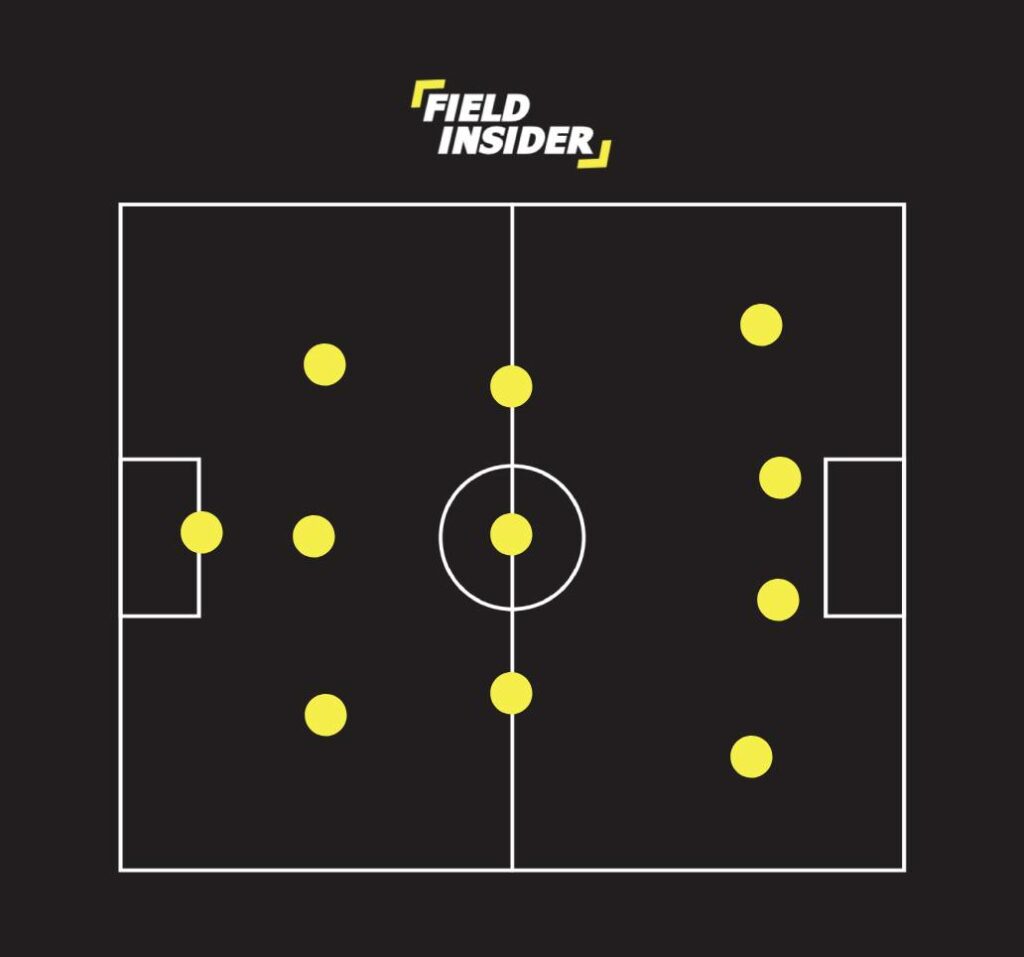
When Should It Be Utilized, And Why?
Despite being less common in regular play due to its defensive vulnerabilities, the 3-3-4 can be exceptionally effective in overwhelming defenses by sheer numbers and persistent attacking presence.
Consequently, this approach often leads to a high-risk, high-reward scenario, making it a bold strategy for teams looking to overturn deficits and make significant impacts in critical phases of a game.
Why is The 3-3-4 A Good Attacking Formation?
The 3-3-4 formation is strategically engineered for an offensive overload, where the presence of four forwards creates a relentless attacking force.
These forwards work in unison to exert continuous pressure on the opposition’s defense, thus leveraging their numerical advantage to open up spaces and craft numerous scoring chances.
This setup allows for diverse attacking plays, from direct assaults on the goal to intricate passing movements that break down defensive structures. The four forwards, often with varied styles and strengths, can confuse and overwhelm defenders, hence leading to increased opportunities for goals.
Furthermore, their coordinated movements and rotations enable them to exploit any weaknesses in the opposition’s backline. Therefore making the 3-3-4 a formidable formation for teams looking to aggressively dominate and outscore their opponents.
Pros & Cons Of The 3-3-4
| Pros | Cons |
|---|---|
| Extremely offensive | Very high defensive risk |
| Overloads the opposition defense | Can be easily exploited on counter-attacks |
| Ideal for chasing a game | Requires highly skilled attackers |
IX. 4-3-1-2 Formation
The 4-3-1-2 formation, recognized for its diamond-shaped midfield, offers a strategic equilibrium between defensive stability and attacking prowess.
The 4-3-1-2 Setup
This formation features a defensive midfielder anchoring the backline, with two central midfielders on either side providing support. At the tip of the diamond, an advanced playmaker bridges the gap between midfield and attack, actively linking the two areas of the pitch.
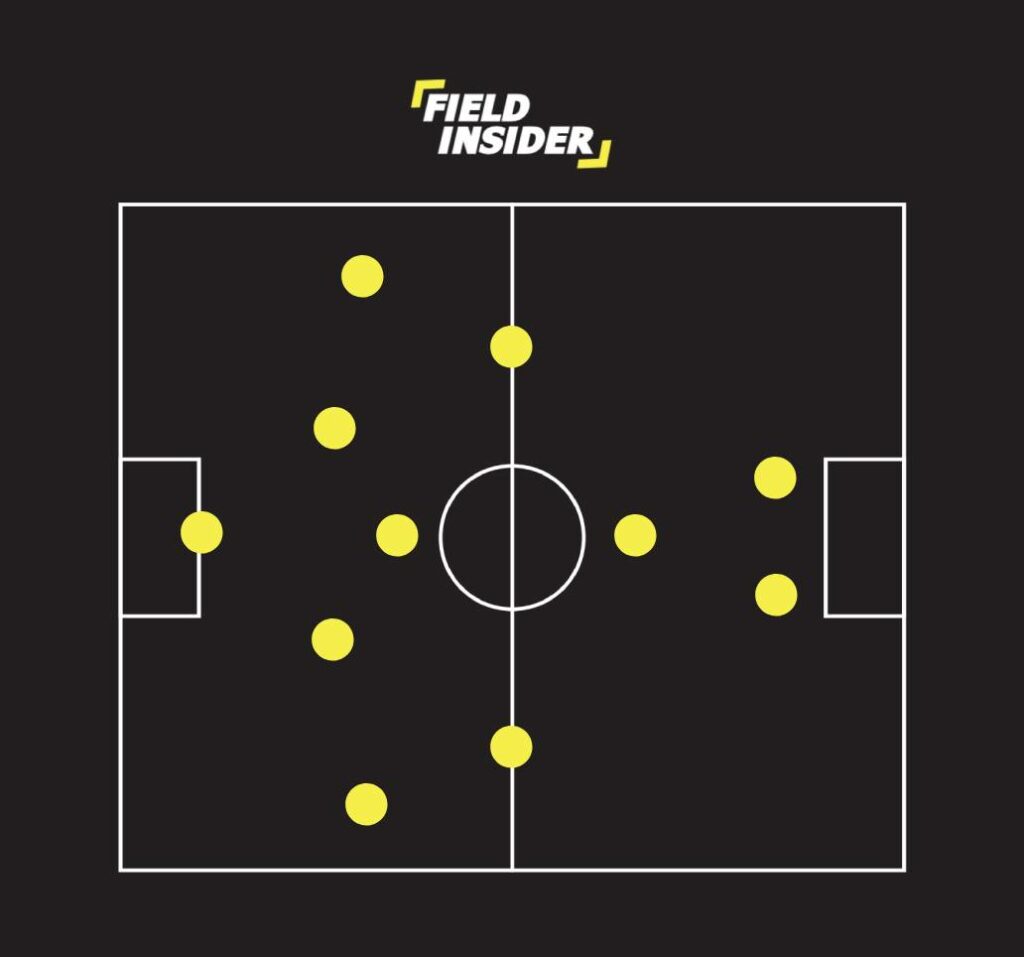
Moreover, this layout facilitates both solid defensive coverage and dynamic offensive options, as the midfielders can fluidly transition between roles.
Ancelotti’s Diamond Domination
AC Milan’s remarkable success under Carlo Ancelotti, notably their Champions League triumph, partly results from his masterful implementation of the 4-3-1-2.
Under Ancelotti, Milan capitalized on this formation’s strengths, utilizing the midfield’s versatility to dominate possession and control the game’s tempo, while the forwards, supported by the advanced playmaker, executed potent attacking moves.
This tactical approach not only brought significant success to AC Milan but also highlighted the 4-3-1-2’s effectiveness in achieving a harmonious blend of tactical discipline and creative freedom.
Why is The 4-3-1-2 A Good Attacking Formation?
In the 4-3-1-2 formation, the attacking strategy is significantly enhanced by the role of the playmaker positioned just behind the strikers. This player serves as the team’s creative fulcrum, orchestrating the attack with vision and finesse.
Their responsibility involves linking play between the midfield and the strikers, consequently, often acting as the conduit for advancing attacks through insightful passes and intelligent positioning.
The formation’s inherently narrow shape naturally facilitates a style of play centered around quick, short passing, hence allowing for swift and intricate combinations in tight spaces.
As a result, this setup enables the team to methodically break down defenses, with the playmaker finding and exploiting gaps, and the strikers utilizing their positioning and movement to capitalize on these opportunities.
Pros & Cons Of The 4-3-1-2
| Pros | Cons |
|---|---|
| Strong central presence | Lacks natural width |
| Good for controlling the midfield | Can be predictable in attack |
| Effective in tight spaces | Requires a highly creative playmaker |
X. 2-3-5 Formation
The 2-3-5 formation, a relic from the early days of football, is famous for emphasizing attacking play.
The 2-3-5 Legacy
The 2-3-5 features an aggressive offensive stance with an ambitious lineup of five forwards who work in tandem to overwhelm defenses through sheer numbers and coordinated movements.
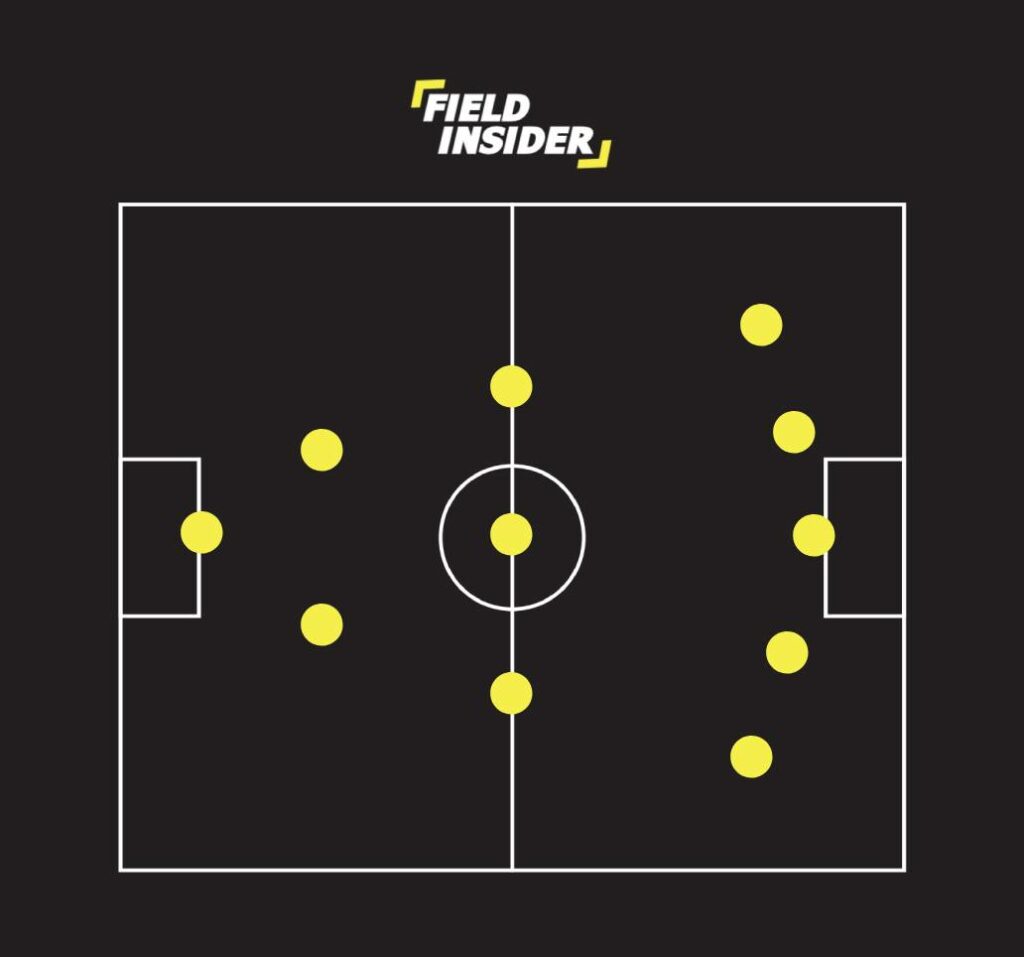
While this formation has largely fallen out of use in modern football, its principles of forward dominance and attacking fluidity have left a lasting impact on the development of offensive tactics.
For this reason, the legacy of the 2-3-5 can still be seen in contemporary formations that prioritize forward play and creative attacking strategies, underlining its historical significance in the tactical evolution of football.
Herbert Chapman’s Gunners
This formation, which was revolutionary at its time, became synonymous with Herbert Chapman’s Arsenal in the 1930s. Under Chapman’s guidance, Arsenal adopted this formation to great effect! As a result, leading them to multiple First Division titles, establishing them as a powerhouse in English football.
The 2-3-5 Setup Under Chapman
His implementation of the 2-3-5 was unique in how he adapted it to the strengths of his players, emphasizing coordinated attacking movements with the five forwards, and a strong midfield trio to control the game.
Additionally, the two defenders, although fewer in number, were strategically positioned to maximize coverage and efficiency in defense.
Why is The 2-3-5 A Good Attacking Formation?
The 2-3-5 formation focuses aggressively on overwhelming the opposition’s defense with its lineup of five forwards, hence creating a multitude of attacking opportunities.
This approach saturates the opponent’s defensive zone, therefore leveraging the sheer number of attacking players to execute diverse and dynamic offensive strategies.
The presence of numerous forwards continuously stretches and outmaneuvers defenses, as a result, leading to a high rate of goal-scoring chances.
Pros & Cons Of The 2-3-5
| Pros | Cons |
|---|---|
| Highly offensive | Very vulnerable defensively |
| Influenced modern attacking play | Outdated in contemporary football |
| Encourages creative forward play | Requires exceptional forward players |
3-5-2 Vs. 4-2-3-1: A Theory-Oriented Comparison
An experimental study, titled “Memmert D, Raabe D, Schwab S, Rein R. A tactical comparison of the 4-2-3-1 and 3-5-2 formation in soccer: A theory-oriented, experimental approach based on positional data in an 11 vs. 11 game set-up.” investigated the effects of two different team formations—4-2-3-1 and 3-5-2—on tactical performance by using player tracking data.
Key performance indicators (KPIs) analyzed included Effective Playing Space (EPS), Player Length per Width ratio (PLpW), Team Separateness (TS), Space Control Gain (SCG), and Pressure Passing Efficiency (PPEI).

No significant differences were found between the formations in terms of EPS, TS, and SCG. However, the 3-5-2 formation resulted in a higher PLpW ratio and PPEI, suggesting that formation can influence specific tactical behaviors in soccer.
For statistical analysis, non-parametric Wilcoxon rank sum tests were used due to the non-normal distribution of the performance metrics. The results showed:
- No significant differences in EPS and TS between the formations.
- The PLpW ratio was significantly higher for the 3-5-2 formation.
- No significant differences in SCG were found.
- The PPEI was significantly higher for the 3-5-2 formation, indicating better passing efficiency under pressure.
In summary, a deeper understanding of team formations and their impact on sports performance, especially in soccer, is crucial. This understanding, when combined with validated KPIs, enable the measurement of coaches’ tactical decision-making.
By conducting experiments that simulate real 11 vs. 11 soccer games, we can test and enhance existing performance analysis theories using the positional data approach. As a result, it is suggested that future research in match analysis across different teams and sports should prioritize this focus.
Conclusion
In conclusion, determining the best offensive formation or the most suitable approach to play offensive football is highly subjective. It hinges on the manager’s philosophy, the capabilities of the players, and external factors like the competition context.
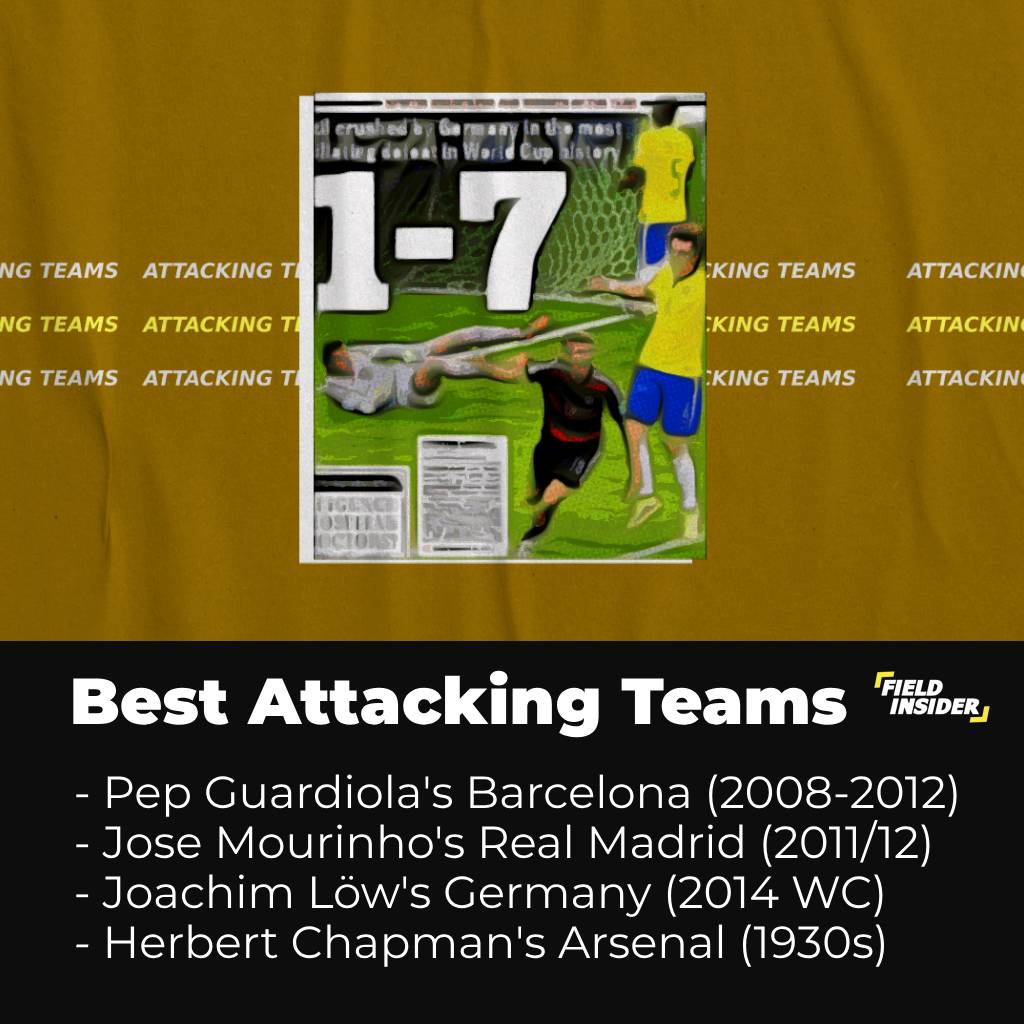
Football’s intricacies constantly influence how a particular attacking formation is perceived. As Alfio Basile, the former Argentina and Boca Juniors manager, aptly put it:
“I place the players correctly in the formation but then the match starts and they move.”





